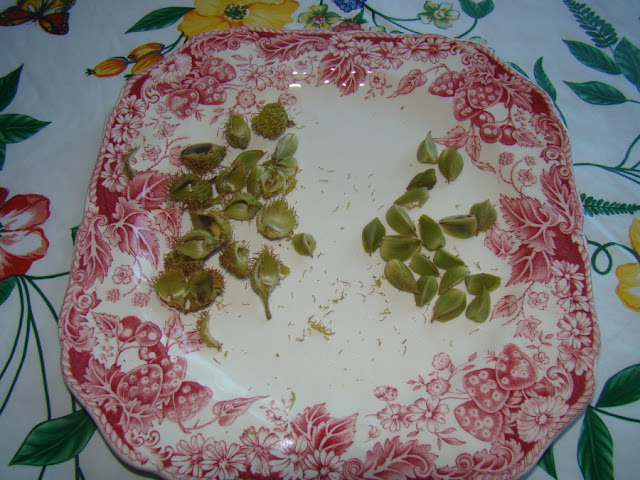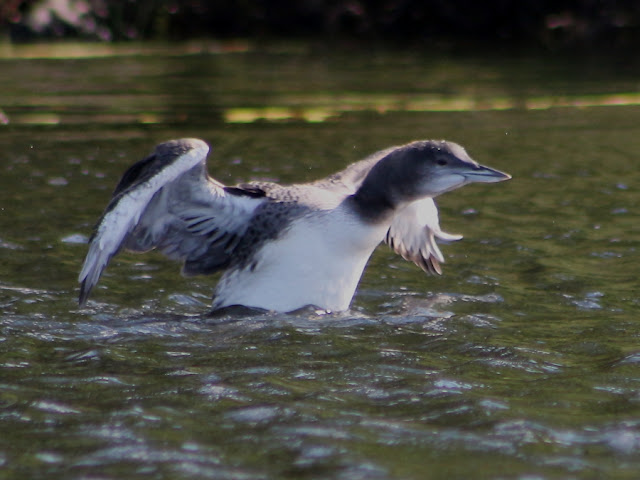This may be a good year for animals that consume beech nuts, such as black bears, red squirrels, deer, chipmunks and many others. I started seeing beech nuts and their husks on the forest floor over a week ago and now they are appearing in large numbers. One quiet morning as I approached a huge old beech tree it sounded like it was raining; I stopped to take in the scene and parts of beech nuts were falling all around me, even bounding off my head: The squirrels were up in the tree feasting on these nutritious nuts. I picked up a handful and brought them home, having heard recently they actually taste pretty good.
Beech nuts are smaller than an acorn and their outer husks are strong and covered with sharp spikes that make opening them a challenge for human hands.
 |
| The outer husk of a beech nut. |
Left on a tree the fruit will split in half, revealing two or three triangular-shaped inner nuts.
 |
| The nuts inside the husks, many of which had been eaten. |
The nut meat, which is quite small, is further hidden inside that inner seed and that's what the animals are ultimately after.
 |
| A seed from which the meat has been consumed. |
I felt only a touch guilty taking some of the squirrel's harvest but when I inspected my collection I realized the animals are smarter than I am. Most of the husks were empty, and most of them that did have nuts still in them also had worms in them - not presently, but earlier in the season - and thus the nuts were not desirable. Here's an example of one with a worm hole in it that the squirrels passed up.
The squirrels must be eating the best nuts up in the tree and leaving the others to fall to the ground along with the shreds of what they had opened or partially eaten. So I ended up with just a few nuts that appear to be edible.
They need to dry for a week or two, and then I'll let you know if I find them palatable.
Beech are patient trees, growing slowly over a long period of time in the lower story of the forest, waiting for their day in the sun. When they finally get their chance - due to a neighboring tree falling down, a forest fire, or logging for example - the exposure to sun results in a burst of growth. But even without any direct sunlight beech trees can inch their way up slowly to become giants of the forest. When the colonists first arrived in North America beech were some of largest trees in the old growth forests along with hemlock and white pine.
Today they are disliked by foresters because beech has little market value. But if logging is done poorly without careful attention to the species in the logged area, after other trees are are removed and the sun let in, beech can easily take over large areas of forest. But being such an important food source for so many of New Hampshire's forest animals, especially after the demise of the American Chestnut due to the asian chestnut blight, it's important to keep them in the forest inventory. And it's always good to see squirrels and deer enjoying their produce; I just hope I don't come across a bear some morning when I'm walking among the beech trees.
I was away most of this past week so I don't have much status on the loons, but I did get one good look at them early in the week, and they continue their rapid progress toward becoming adults.
 |
| Coco and Jimmy, age 60 days. |
But neither they or their parents better let their guard down because there are still hungry eagles visiting Lake Wicwas on a regular basis.
 |
| Photo by Debby Crowley. |
Debby Crowley saw this bald eagle on Wednesday; the bit of something hanging from its beak is curious.
Let's hope Coco and Jimmy's parents continue their careful safeguarding of their chicks.
 |
| Photo by Debby Crowley. |






We have lots on beech trees on our property but they have not dropped their seed nuts yet. We usually find quite a few in September. Interesting, we are finding a group on oak leaves that have fallen into our yard. We don't know if the squirrels are chewing them off or the oak tree is dropping them in wind storms. It is quite puzzling!
ReplyDeletePlease let me know about your beech crop this year. I don't know if farther norther they'd drop earlier because it gets cooler sooner, or later because they started growing later in the spring. Our oaks always seem to lose a lot of small branches in the wind too.
Delete